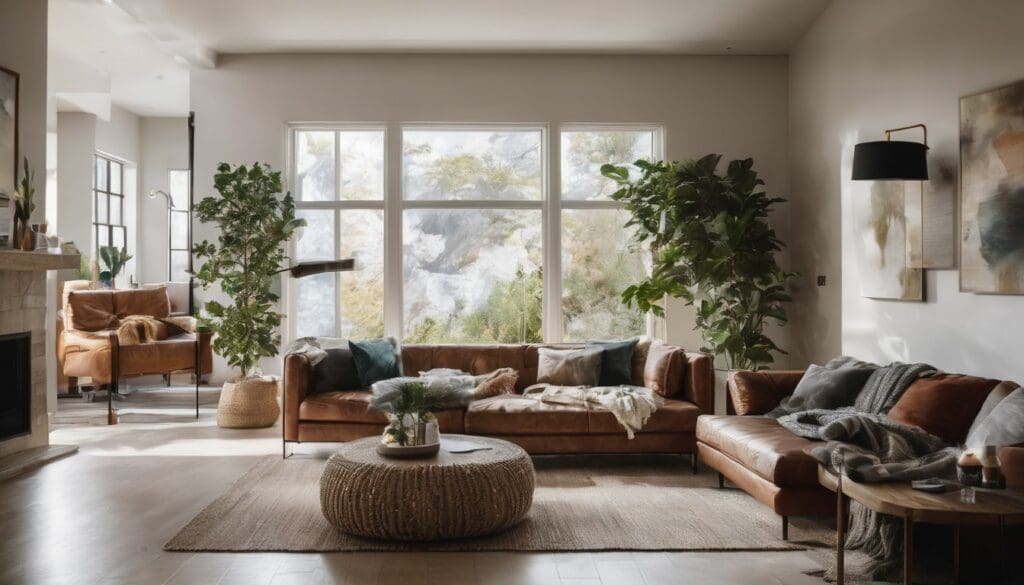We’re all familiar with that gentle push towards making our homes a touch more sustainable. And if you’re anything like us, figuring out where to begin can be quite the conundrum. Fear not, though; we’ve taken it upon ourselves to do the legwork for you.
You might be interested to learn that the market for eco-friendly furniture is forecasted to soar to an impressive $174.9 billion by 2027! We’ve compiled our research into this piece, showcasing the freshest trends in sustainable home decor—designs that are as kind on the eye as they are on our precious environment.
So come along and let’s navigate these green waters together for a home that’s both chic and earth-conscious!
Key Takeaways
- Reclaimed and recycled materials like aged barn wood can be repurposed to create unique and eco – friendly furniture items.
- Opting for natural and organic fabrics such as linen, hemp, and bamboo is crucial for reducing environmental impact during production while fostering a healthier indoor environment.
- Bamboo, cork, and reclaimed wood are sustainable flooring options that provide style, durability, and a reduced ecological footprint.
- Energy – efficient home designs incorporate low VOC paints, LED or CFL bulbs for lighting solutions, smart thermostats for energy savings, contributing to lower bills and sustainability.
- Incorporating biophilic design principles with elements like indoor plants improves air quality while embracing minimalism reduces the need for excess resources.
Sustainable Materials for Home Decor
When it comes to sustainable home decor, using reclaimed and recycled materials is a popular trend. Natural and organic fabrics are also a great choice for eco-friendly interiors.
Reclaimed and Recycled Materials
We’ve seen the beauty and durability that reclaimed wood brings to our sustainable interior design projects. It’s not just about giving old lumber a new life; it tells a story of the past while reducing the need for fresh timber.
By choosing recycled materials, we also lessen our impact on landfills. Imagine a coffee table shaped from aged barn wood or shelves crafted with history-thickened planks – these pieces are not only environmentally sound but bring unmatched character to any space.
Our commitment to sustainability doesn’t end at salvaged wood. We’re constantly scouring for ecofriendly household items that repurpose what others might discard. From bamboo decor pieces that showcase versatility and rapid renewability to cork furniture known for its low environmental footprint, we’re embracing materials that both protect our planet and elevate our homes’ aesthetics.
Next, let’s touch upon how natural and organic fabrics can further enhance your green home decor.
Natural and Organic Fabrics
Choosing natural and organic fabrics for home decor is essential for creating an eco-friendly living space. These fabrics, such as organic cotton, linen, hemp, and bamboo, are sustainably sourced and free from harmful chemicals.
They provide a healthier indoor environment by reducing exposure to toxins often found in conventional textiles. Natural fabrics also have a lower environmental impact during production, making them a more sustainable choice for environmentally conscious individuals looking to reduce their carbon footprint.
Additionally, embracing natural and organic fabrics aligns with the principles of eco-conscious living and supports the conservation of our planet’s resources.
Incorporating natural and organic fabrics into home decor not only promotes sustainability but also enhances the overall aesthetic appeal of the living space. From curtains and upholstery to bedding and table linens, these materials offer a soft touch while contributing to a greener lifestyle.
Sustainable Flooring Options
When sourcing sustainable flooring options, consider materials such as bamboo, cork, or reclaimed wood. These alternatives are eco-friendly and durable, offering a stylish finish to any space.
Bamboo is highly renewable and lends a contemporary look, while cork provides natural insulation and absorbs sound. Reclaimed wood offers a rustic charm and reduces the demand for new timber, promoting responsible forestry practices.
Exploring these sustainable flooring options can significantly reduce your environmental impact while elevating your home decor with ethical choices.
Energy Efficiency in Home Design
When it comes to sustainable home decor, energy efficiency is a key factor. Low VOC paints and finishes, energy-efficient lighting, and smart thermostats are all essential elements in creating an eco-friendly living space.
These choices not only reduce environmental impact but also contribute to lower energy bills and a healthier indoor environment.
Low VOC Paints and Finishes
When selecting paints and finishes for our homes, it’s essential to opt for low VOC options. These products release fewer volatile organic compounds into the air, promoting better indoor air quality and reducing potential health risks.
By choosing low VOC paints and finishes, we contribute to a healthier environment while creating a sustainable living space that aligns with our eco-friendly values. It’s important to seek out environmentally safe paint when designing our living spaces, ensuring that our home decor reflects our commitment to sustainability.
Opting for low VOC paints and finishes not only benefits the environment but also supports ecoconscious living. These products are in line with the green interior design trends that promote environmentally friendly decor choices.
Energy-Efficient Lighting
To reduce energy consumption, choose LED or CFL bulbs over traditional incandescent lights. These bulbs are more energy-efficient and have a longer lifespan. LED lights are perfect for task lighting with their directional illumination, while CFLs work well for ambient or general lighting. Both types of lighting also come in a range of colour temperatures to suit different areas of your home.
Smart Thermostats and Home Automation
Following energy-efficient lighting, embracing smart thermostats and home automation can greatly enhance the sustainability of your home. These technologies allow for precise control over heating and cooling, reducing energy waste and lowering utility bills.
- Programmable Thermostats: By setting schedules that align with your daily routine, programmable thermostats ensure that you’re not heating or cooling an empty house, saving both energy and money.
- Remote Access: With the ability to adjust temperatures from anywhere using a smartphone app or web interface, you can avoid wasting energy when unexpected changes occur in your schedule.
- Occupancy Sensors: These sensors detect when a room is unoccupied and automatically adjust the temperature settings to conserve energy.
- Integration with Home Automation Systems: Smart thermostats can be integrated into broader home automation systems, allowing for centralised control of various functions within the house.
- Learning Capabilities: Some smart thermostats have learning capabilities, adapting to your preferences and adjusting settings accordingly without manual input.
- Energy Usage Reports: Many smart thermostats provide detailed reports on energy usage patterns, enabling you to identify areas where further savings can be made.
- Compatibility with Renewable Energy Sources: They can be integrated with renewable energy sources like solar panels, maximising the use of clean energy based on real-time data.
Incorporating Nature in Home Decor
Bring the outdoors inside with indoor plants and green walls to create a biophilic design that promotes wellbeing. Click here to explore more sustainable home decor ideas!
Indoor Plants and Biophilic Design
Indoor plants and biophilic design bring a touch of nature into our living spaces, promoting well-being and connection to the environment. By incorporating greenery into our homes through potted plants or vertical gardens, we can improve air quality, reduce stress, and enhance overall happiness.
Biophilic design principles encourage the use of natural elements such as wood, stone, and water features to create a harmonious and calming atmosphere within interiors. Embracing this approach not only supports sustainability but also fosters a deeper appreciation for the beauty of the natural world in our daily lives.
Integrating indoor plants and biophilic design into our homes cultivates a sense of tranquillity while reducing energy consumption. The presence of lush foliage indoors contributes to cleaner air by absorbing pollutants and releasing oxygen.
Green Walls and Roofs
Green walls and roofs are excellent ways to incorporate nature into home decor, promoting sustainability and eco-friendliness. Living walls not only add a splash of greenery but also improve air quality by trapping pollutants and releasing oxygen.
These vertical gardens can be created using various plants, such as ferns, succulents, and mosses, offering a visually appealing and environmentally beneficial feature for the home.
On the other hand, green roofs provide insulation, reducing energy consumption while creating natural habitats for birds and insects. The addition of these elements aligns with the ecoconscious trend in interior design.
Embracing Minimalism and Upcycling
We’ll discuss the benefits of decluttering for a sustainable home and how to incorporate DIY and upcycling projects into your interior design. Want to learn more about embracing minimalism and upcycling in sustainable home decor? Keep reading!
Decluttering for a Sustainable Home
To create a sustainable home, we can start by decluttering our living spaces and embracing minimalism. By doing so, we reduce the need for excess materials and resources. Here are some practical ways to declutter for a sustainable home:
- Donate or recycle items that you no longer use or need. This reduces waste and promotes the reuse of goods.
- Invest in multifunctional furniture pieces that serve more than one purpose, such as storage ottomans or coffee tables with built-in shelving.
- Utilise vertical storage solutions to maximise space and minimise clutter, such as wall-mounted shelves and floating cabinets.
- Implement a “one in, one out” rule when bringing new items into your home to maintain a balanced and clutter-free environment.
- Create designated spaces for items to prevent unnecessary accumulation of belongings, ensuring everything has its place.
- Opt for timeless and versatile decor pieces that have longevity rather than following fleeting trends, reducing the need for frequent replacements.
- Adopt digital alternatives for paper clutter by opting for e – bills, digital subscriptions, and scanning important documents to reduce physical filing needs.
DIY and Upcycling Projects
- Revamp old furniture with low VOC paints and finishes, giving them a new lease of life while avoiding harmful chemicals.
- Create unique decor accents by upcycling glass jars, cans or bottles into decorative vases or candle holders.
- Reimagine worn textiles into cushion covers or throw blankets using natural and organic fabrics, adding a touch of sustainability to your interiors.
- Build shelving or storage units from reclaimed materials such as pallet wood for a stylish and environmentally friendly storage solution.
- Utilise salvaged wood to craft bespoke picture frames or wall art, infusing your space with eco – friendly charm.
- Design your own indoor herb garden using recycled containers, bringing nature indoors while reducing packaging waste.
Conclusion
In conclusion, sustainable home decor trends focus on eco-friendly materials and energy-efficient design. Embracing nature with indoor gardens and upcycling accent pieces adds a touch of sustainability to any home.
Minimalism and upcycling projects are key elements in creating an environmentally conscious living space. By incorporating these trends, we can contribute to a greener future while enjoying stylish and sustainable home decor.
FAQs
1. What does ecofriendly home decor mean?
Ecofriendly home decor means using materials and designs that are good for the environment, like upcycled accessories and sustainable furniture.
2. How can I add sustainability to my house’s interior design?
You can introduce indoor gardens, use upcycled accent pieces, and choose furniture made with sustainable practices to make your home’s interior greener.
3. Are there specific trends in ecoconscious home decor?
Yes, trends include using ecologically responsible materials in furnishings and seeking out green design elements that minimise environmental impact throughout the home.
4. Where can I find inspiration for ecofriendly interior design?
Look for ideas on how to incorporate reclaimed items as functional decorative elements or embrace natural themes by bringing outdoor elements inside your living space.





